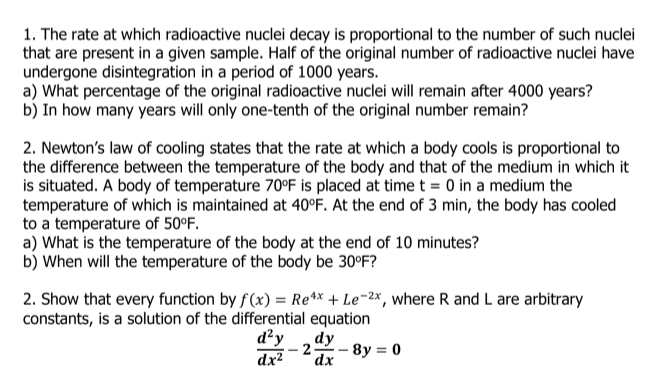1. The rate at which radioactive nuclei decay is proportional to the number of such nuclei that are present in a given sample. Half of the original number of radioactive nuclei have undergone disintegration in a period of 1000 years. a) What percentage of the original radioactive nuclei will remain after 4000 years? b) In how many years will only one-tenth of the original number remain?
1. The rate at which radioactive nuclei decay is proportional to the number of such nuclei that are present in a given sample. Half of the original number of radioactive nuclei have undergone disintegration in a period of 1000 years. a) What percentage of the original radioactive nuclei will remain after 4000 years? b) In how many years will only one-tenth of the original number remain?
Algebra and Trigonometry (MindTap Course List)
4th Edition
ISBN:9781305071742
Author:James Stewart, Lothar Redlin, Saleem Watson
Publisher:James Stewart, Lothar Redlin, Saleem Watson
Chapter4: Exponential And Logarithmic Functions
Section4.CR: Chapter Review
Problem 13CC: Suppose that the initial mass of radioactive substance is m0 and the half-life of the substance is...
Related questions
Question

Transcribed Image Text:1. The rate at which radioactive nuclei decay is proportional to the number of such nuclei
that are present in a given sample. Half of the original number of radioactive nuclei have
undergone disintegration in a period of 1000 years.
a) What percentage of the original radioactive nuclei will remain after 4000 years?
b) In how many years will only one-tenth of the original number remain?
2. Newton's law of cooling states that the rate at which a body cools is proportional to
the difference between the temperature of the body and that of the medium in which it
is situated. A body of temperature 70°F is placed at time t = 0 in a medium the
temperature of which is maintained at 40°F. At the end of 3 min, the body has cooled
to a temperature of 50°F.
a) What is the temperature of the body at the end of 10 minutes?
b) When will the temperature of the body be 30°F?
2. Show that every function by f (x) = Re ** + Le-2*, where R and L are arbitrary
constants, is a solution of the differential equation
d²y
dy
-2.
dx²
- 8y = 0
dx
Expert Solution
This question has been solved!
Explore an expertly crafted, step-by-step solution for a thorough understanding of key concepts.
This is a popular solution!
Trending now
This is a popular solution!
Step by step
Solved in 3 steps with 3 images

Recommended textbooks for you

Algebra and Trigonometry (MindTap Course List)
Algebra
ISBN:
9781305071742
Author:
James Stewart, Lothar Redlin, Saleem Watson
Publisher:
Cengage Learning

Linear Algebra: A Modern Introduction
Algebra
ISBN:
9781285463247
Author:
David Poole
Publisher:
Cengage Learning

Algebra: Structure And Method, Book 1
Algebra
ISBN:
9780395977224
Author:
Richard G. Brown, Mary P. Dolciani, Robert H. Sorgenfrey, William L. Cole
Publisher:
McDougal Littell

Algebra and Trigonometry (MindTap Course List)
Algebra
ISBN:
9781305071742
Author:
James Stewart, Lothar Redlin, Saleem Watson
Publisher:
Cengage Learning

Linear Algebra: A Modern Introduction
Algebra
ISBN:
9781285463247
Author:
David Poole
Publisher:
Cengage Learning

Algebra: Structure And Method, Book 1
Algebra
ISBN:
9780395977224
Author:
Richard G. Brown, Mary P. Dolciani, Robert H. Sorgenfrey, William L. Cole
Publisher:
McDougal Littell



Trigonometry (MindTap Course List)
Trigonometry
ISBN:
9781337278461
Author:
Ron Larson
Publisher:
Cengage Learning